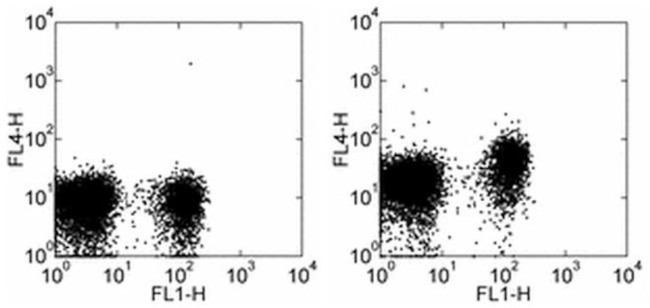Search Thermo Fisher Scientific
Invitrogen
CD197 (CCR7) Monoclonal Antibody (4B12), Alexa Fluor™ 700, eBioscience™
FIGURE: 1 / 16
CD197 (CCR7) Antibody (56-1971-82) in Flow

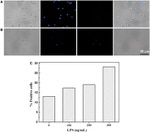

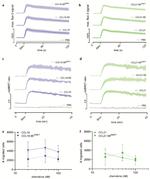
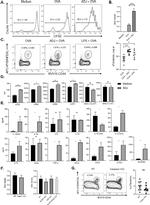
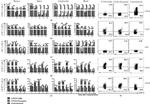

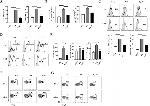
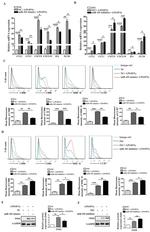

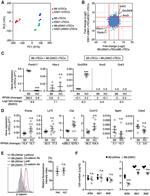
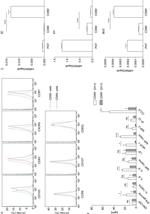
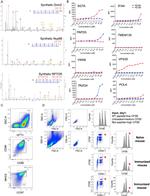
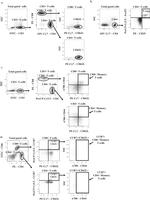
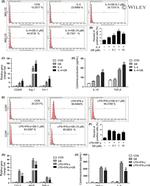
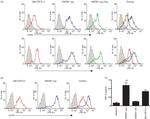
Product Details
56-1971-82
Species Reactivity
Published species
Host/Isotype
Recommended Isotype Control
Class
Type
Clone
Conjugate
Excitation/Emission Max
Form
Concentration
Purification
Storage buffer
Contains
Storage conditions
Shipping conditions
RRID
Product Specific Information
Description: The 4B12 monoclonal antibody reacts with mouse CCR7, also known as EBI-1 and CD197. CCR7 is a chemokine receptor for the chemokines CCL19 (CKβ11, ELC, MIP3β, Scya19, Exodus-3) and CCL21 (CKβ9, SLC, MIP2β, Scya21, Exodus-2). In recent years, the role of chemokines in directing the migration of lymphocytes has been well-characterized. One of the most important mediators of homeostatic trafficking of naive T cells to secondary lymphoid organs (SLO) is the chemokine receptor CCR7. Binding of its ligands, CCL19 and CCL21, mediates the trans endothelial migration of T cells across high endothelial venules into SLO. It has also been demonstrated that CCR7 plays a role in the localization of dendritic cells and B cells during an immune response.
CCR7 is a chemokine receptor for the chemokines CCL19 (CKβ11, ELC, MIP3β, Scya19, Exodus-3) and CCL21 (CKβ9, SLC, MIP2β, Scya21, Exodus-2).
In addition to its significant role in the chemotaxis of lymphocytes, human CCR7 has also been recognized as a marker for a distinct subset of memory T cells, the central memory (TCM) population. These cells are characterized by the expression of CCR7 and CD62L and reside within peripheral lymphoid organs. CCR7 also plays a role in thymocyte development and its deficiency leads to disturbed thymic architecture, aberrant T cell development, and limited thymocyte expansion.
For optimal visualization of CCR7 expression on different cell types it is necessary to use multi-color staining to discriminate different cell subsets as well as following the protocol (incubation at 37C may be necessary). To address specificity, the staining profile of 4B12 has been compared to a polyclonal antibody generated against a CCR7 peptide (Bjorkdahl et al). This analysis confirms that the polyclonal antibody and 4B12 stain similar populations of cells. Furthermore, 4B12 stains mouse CCR7-GFP fusion protein-transfected RBL cells (see data in Product # 14-1971).
Applications Reported: This 4B12 antibody has been reported for use in flow cytometric analysis.
Applications Tested: The 4B12 antibody has been tested by flow cytometric analysis of mouse splenocytes and thymocytes. This can be used at less than or equal to 1 µg per test. A test is defined as the amount (µg) of antibody that will stain a cell sample in a final volume of 100 µL. Cell number should be determined empirically but can range from 10^5 to 10^8 cells/test. It is recommended that the antibody be carefully titrated for optimal performance in the assay of interest.
The Alexa Fluor® 700 emits at 723 nm and can be excited with the He-Ne 633 laser. Most instruments will require a 685 LP mirror and 710/20 filter. Please make sure that your instrument is capable of detecting this fluorochrome.
Important: Staining with the 4B12 monoclonal antibody requires different conditions than typically used for surface-antigen staining. Please use the protocol below. Moreover, we have found that staining at 37°C, rather than 2-8°C, results in brighter 4B12 staining, as well as better resolution between positive and negative populations. Please see the data above which demonstrates a comparison of staining at 2-8°C and 37°C. Staining with 4B12 at 37°C is not expected to interfere with co-staining other antigens, however this should be evaluated for individual experiments.
1. Prepare cell suspension as normal and block Fc gamma III R/Fc gamma II R with 5 µg/million cells purified anti-mouse CD16/32 (Product # 14-0161) for 15 minutes on ice. If red blood cell lysis is carried out as part of cell preparation, ensure that fixatives are not present in the red blood cell lysis solution as this will eliminate 4B12 staining.
2. Without washing, add 1 µg/million cells 4B12 and incubate in a 37°C waterbath or at 2-8°C (please see notes above) for 0.5 hours.
3. Wash cells 1X with 3 mL of Flow Cytometry Staining Buffer (Product # 00-4222) and decant supernatant.
4. Analyze cells on flow cytometer or proceed with secondary staining on ice as normal.
Note: Co-staining mouse CCR7 with the 4B12 antibody and the CCR7 ligand CCL19-Fc (Product # 14-1972) may be difficult due to different binding conditions required for the antibody versus the ligand, and steric hindrance which may prevent co-staining of 4B12 and CCL19-Fc. Cross-blocking experiments have demonstrated that 4B12 binding is able to prevent the detectable binding of CCL19-Fc, however not the opposite. Furthermore, the correlation between 4B12 and CCL19-Fc staining may be difficult to predict due to the presence of unknown CCL19-Fc receptors in addition to CCR7.
Excitation: 633-647 nm; Emission: 723 nm; Laser: Red Laser.
Filtration: 0.2 µm post-manufacturing filtered.
Target Information
CCR7 is a member of the G protein coupled receptor family, which is a subfamily of chemokines. CCR7 was identified to be induced by the Epstein Barr virus (EBV), and is thought to be a mediator of EBV effects on B lymphocytes. CCR7 has been reported to be expressed in blood, bone marrow, lymph node, and intestine. CCR7 is particularly expressed in lymphoid tissues and in activated B and T lymphocytes and has been shown to control the migration of memory T cells to inflamed tissues, as well as stimulate dendritic cell maturation. The chemokine (C-C motif) ligand 19 (CCL19/ECL) has been reported to be a specific ligand of this receptor. ESTs have been isolated from blood, embryo, lymph node, and thymus libraries. Receptors for the C - C chemokine family include CCR 1, CCR 2A, CCR 3, CCR 4, CCR 5 and the Duffy blood group antigen. The C-C receptors are important in the function of T cell chemotaxis and migration of phagocytic cells to sites of inflammation.
For Research Use Only. Not for use in diagnostic procedures. Not for resale without express authorization.
How to use the Panel Builder
Watch the video to learn how to use the Invitrogen Flow Cytometry Panel Builder to build your next flow cytometry panel in 5 easy steps.
Bioinformatics
Protein Aliases: C-C chemokine receptor type 7; C-C CKR-7; CD197; chemokine (C-C) receptor 7; EBI1; EBV-induced G-protein coupled receptor 1; Epstein-Barr virus-induced G-protein coupled receptor 1; MIP-3 beta receptor
Gene Aliases: CC-CKR-7; CCR-7; Ccr7; CD197; Cdw197; Cmkbr7; EBI1; Ebi1h
UniProt ID: (Mouse) P47774
Entrez Gene ID: (Mouse) 12775

Performance Guarantee
If an Invitrogen™ antibody doesn't perform as described on our website or datasheet,we'll replace the product at no cost to you, or provide you with a credit for a future purchase.*
Learn more
We're here to help
Get expert recommendations for common problems or connect directly with an on staff expert for technical assistance related to applications, equipment and general product use.
Contact tech support
